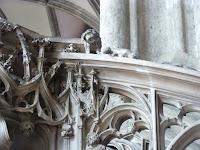

Day 2 in the Alps and the day when the serious hiking happens. This is for me the highlight of the trip, the part I had been waiting for ever since I got here.I was a little worried about the weather, because I had forgotten to pack my rain jacket and it had been storming the day before. The weather, however, was amazing. Sunny weather, minimal clouds (in the distance). You couldn’t ask for better weather. Breakfast was provided a the hotel, and we hit the trail around 10. We hiked from hut to hut, stopping along the way for pictures and food. We didn’t have to pack much because we could refill water or eat something at any of the huts. Along the way we saw some amazing scenery, but little wildlife, unfortunately. I'm glad I had actual hiking shoes, as there were some pretty significant climbs and descents
Our final destination was the Habsburghaus, which we arrived at around 1:30 or 2. I was usually at least 10 minutes ahead of the group I was with. I was glad to get out of the city and into nature, something I haven’t seen much of since I left the Boy Scouts.
Definitely the highlight of this trip was getting lost in the Alps. We started out from Habsburghaus and were trying to take a different route back. Mike Wasserman and I walked faster than the group, and were soon about 20 minutes ahead. When we realized that we had no idea how to get to the hut that everyone else was headed to, we decided to just follow signs back to Ottohaus. After a while, Ottohaus stopped appearing on the signs, and further on, the signposts themselves disappeared. We somehow got back on a path, and decided we needed to go up. When we got to the top of this path, we realized we were back where we had stopped for lunch. We had backtracked to our original path instead of going forwards. In total, we did about an hour of extra hiking, bringing our total mileage to around 14 miles.














 ight to rule the world. This ideal empire is again idealized by the AEIOU philosophy (Alles Erdreich ist
ight to rule the world. This ideal empire is again idealized by the AEIOU philosophy (Alles Erdreich ist 
















